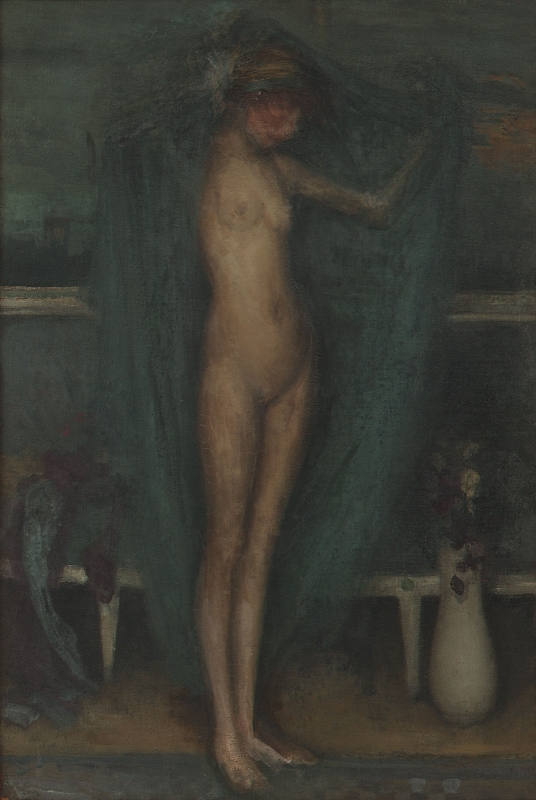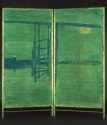Home > Catalogue > People > Arthur Jerome Eddy (related works) > Catalogue entry
Composition
There are several small drawings that relate to the composition: Sketch of 'Harmony in Blue and Gold: The Little Blue Girl' [M.1379], dating from 1893, Nude figure standing, holding a veil [M.1487], from 1897, and Sketch of 'Harmony in Blue and Gold: The Little Blue Girl' [M.1610], from 1900.
A similar pose is seen in Rose et vert: Une étude [YMSM 489].
The screen in the background of Harmony in Blue and Gold: The Little Blue Girl is Blue and Silver: Screen, with Old Battersea Bridge [YMSM 139].
Technique
The canvas is nearly a 'toile de vingt' (73 x 50cm) and may have been acquired in Paris. The paint has been applied in multiple thin layers, rubbed down, and reworked, so that the surface is uneven.
There are alterations to the drapery held by the girl, the position of her feet, and around her head.
Conservation History
Freer Gallery files record that it was relined, cleaned, and resurfaced in 1922, retouched and resurfaced in 1931, and cleaned and surfaced in 1935 and 1951. A technical examination conducted by R. J. Gettens in 1959, in collaboration with Dr Robert Feller from the Mellon Institute, showed that not only had the painting darkened, but that the repeated over-painting of the face by Whistler had resulted in 'wrinkling and distortion of the paint film'. Furthermore, the varnish had a blueish bloom. The vase at lower right had been retouched, and these brush marks had whitened (tests showed the presence of both zinc and lead white in the retouching), while varnish over these marks was brittle. The painting was restored in 1965, when Ben Johnson removed the old varnish and retouching, and treated it with some inpainting and a final varnish.
Frame
Frame, two panels with a chequered pattern, signed with a butterfly. The design was painted, according to a note by C. L. Freer, some time between 1894 and 1903; however, the black and white chequered pattern was a symbol of Whistler's mourning for the death of his wife Beatrice Philip (Mrs E. W. Godwin, Mrs J. McN. Whistler) (1857-1896) in 1896. 1
It is unusual in Whistler's work in having the frame signed, but not the picture. The pattern on the frame continues the pattern of the matting on the floor, and the signature emphasizes the fact that the frame is an integral part of the design. It is the last picture to have a frame decorated by Whistler. 2
Last updated: 7th June 2021 by Margaret













